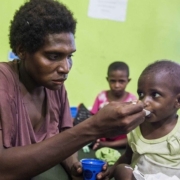
According to the Indonesian Bureau of Statistics, cigarettes are the second largest household expenditure after rice for poor families. Photo by Martin Garrido on Flickr.
Indonesia ranks fifth in the world for stunting. In 2013, nine million children, a third of Indonesian children aged under five years, were stunted, meaning that they were too short for their age
Despite significant government attention to the issue, rates of child stunting remain stubbornly high in Indonesia. The 2018 Indonesian Basic Health Survey recorded a stunting prevalence of 30.8 per cent, which makes Indonesia a high prevalence country, according to WHO cut-off values.
The government has implemented various interventions to tackle stunting. These have included pre-birth interventions, such as vitamins and supplements not only for pregnant and lactating mothers but also for adolescents and brides-to-be who may become pregnant. The government has also supported the First 1000 Days program, which focuses on providing quality nutrition and healthcare and a clean and healthy environment for the first 1,000 days of a child’s life, that is, from conception to age two.
Likewise, the government’s Community Based Total Sanitation Program (STBM) in its Clean and Healthy Lifestyle (PHBS) project and the Community Based Health and Nutrition Project to Reduce Stunting both seek to address the problem.
The scope of these programs cover nutrition-specific interventions (to address direct causes) as well as general interventions beyond the health sector (for example, improving sanitation through regular hand washing and improving access to clean water). These are, of course, critical factors to address – stunting is caused by poor nutrition, repeated infections, and inadequate psychosocial stimulation, so improving nutrition and sanitation is key to preventing the problem. But there is another important element that is rarely acknowledged as a significant factor contributing to stunting – smoking.
Research has shown an indirect correlation between parental smoking and increased risk of stunting among children in poor urban families in Indonesia. A 2006 study by Semba et al revealed an association between paternal smoking and severe stunting and severe wasting.
According to the study, children with a father who was a smoker were likely to be more at risk of stunting because of the diversion of expenditure from foods that could improve childhood nutrition. The proportion of weekly per capita household expenditures on quality foods such as eggs, fish, fruits and vegetables was reduced in households where the father was a smoker.
Indonesia is well-known for having the highest rates of smoking among male adults in the world, with more than 70 per cent of adult males smoking, more than half of whom are from low-middle income households. The Indonesian Bureau of Statistics has also stated that cigarettes are the second largest household expenditure after rice for poor families.
Several reasons are suggested for high (and increasing) rates of smoking among males in Indonesia. It is an often stated but critical point that Indonesia is the only country in the Asia Pacific region that has not signed and ratified the Framework Convention on Tobacco Control. There are few regulations that restrict the tobacco industry from advertising in cinemas, on television, radio, the internet and billboards, or at sporting events and music concerts. And there is only very weak enforcement of the handful of tobacco control regulations that do exist. Moreover, tobacco companies have been very adept at popularising the narrative that smoking is part of Indonesia’s cultural heritage. These factors have together helped to normalise high rates of smoking in the country.
There are varying and conflicting opinions among religious leaders and prominent Islamic organisations about smoking. The largest Islamic organisation in Indonesia, Nahdlatul Ulama, considers smoking to be permissible (makhruh). This reinforces tobacco use as religiously acceptable behaviour. Meanwhile, Muhammadiyah has published a religious opinion (fatwa) saying that smoking is haram, or forbidden. The country’s top clerical body, the Indonesian Council of Ulama (MUI), has also issued a fatwa stating that smoking is forbidden in public, in front of children and for pregnant women. This ambivalence among Muslim organisations may have made it easier for smokers to ignore religious prohibitions on smoking.
A further concern relates to how the government is designing and communicating its programs to tackle stunting, which do not always consider community needs and expectations. Although it used a small sample size, a qualitative study in Tangerang district, Banten, found that interview respondents were not familiar with the term “stunting” as relating to children with short body heights because of poor development. Further, interview respondents did not realise that stunting was a health or nutrition issue, and that it could be influenced by parental behaviour.
Given there has not been any other comprehensive research analysing the casual relationship between smoking and stunting since Semba’s regression study, further research is needed to investigate the correlation between these variables, especially since rates of smoking in Indonesia have increased considerably since then. A detailed qualitative study could help provide further context to the relationship between smoking and stunting, which may not be captured through quantitative approaches such as surveys.
There is no doubt that the government is aware of the huge toll stunting can take on the country’s development and is seeking to address the problem. But efforts to address the problem appear to be missing a major part of the picture.
Evidence suggests further efforts to educate and raise awareness of the adverse impacts of smoking may make an important contribution to the government’s attempts to reduce stunting. But such a strategy would require the government to stand up to the cigarette companies that have such a grip over the population – something that, as yet, no government in Indonesia has appeared willing or able to do.









